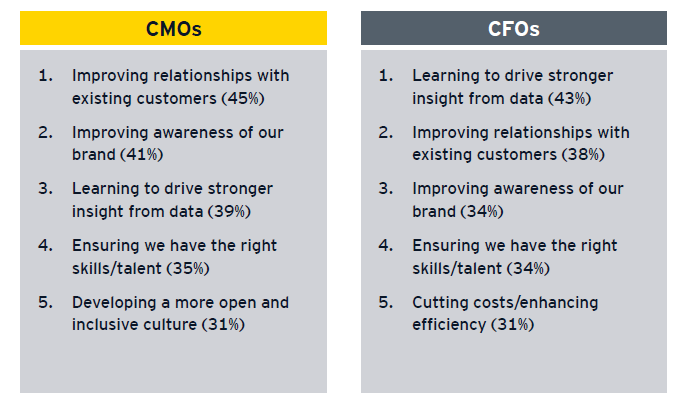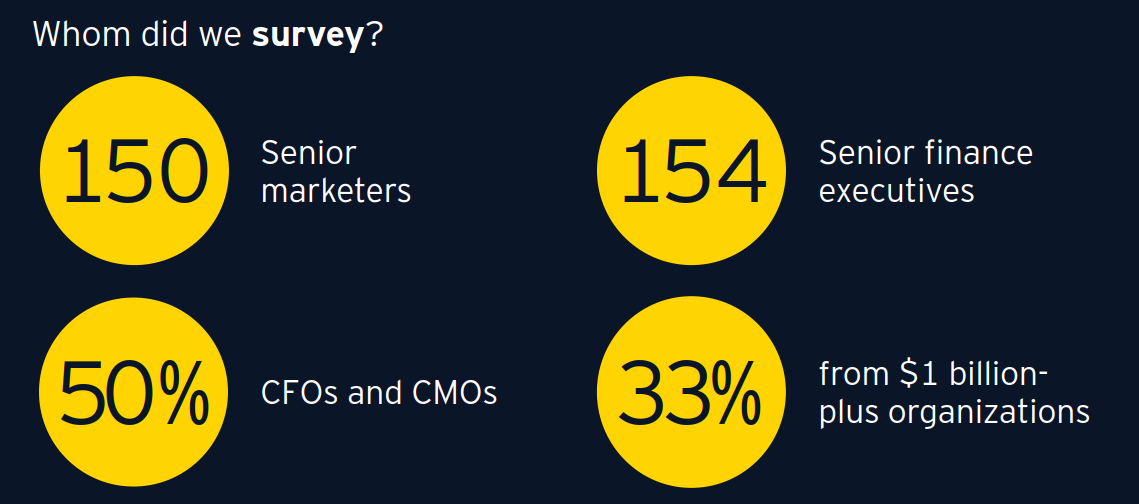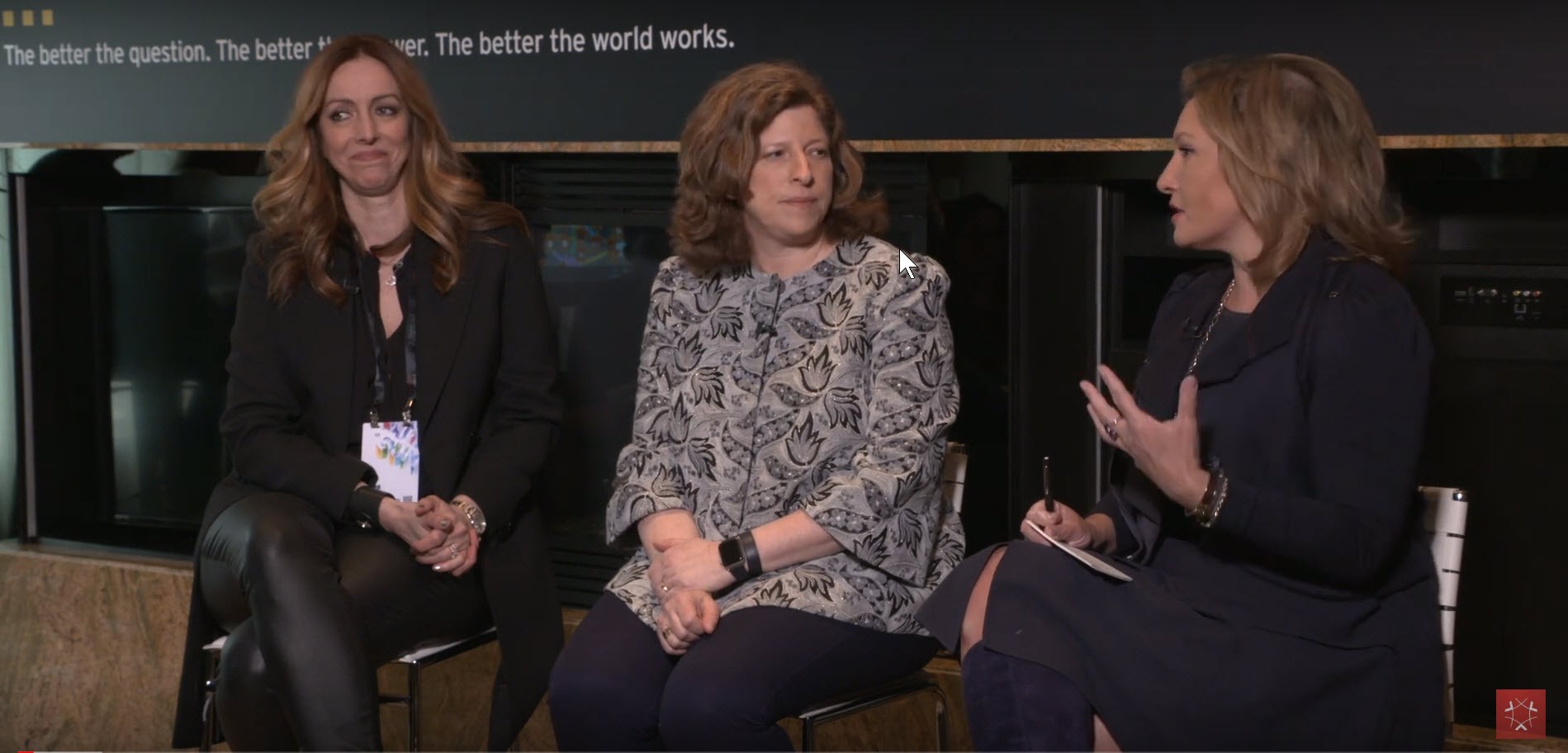
Chapter 1
Marketing and finance need to create a healthy dynamic
For CMOs and CFOs, forging deeper, strategic relationships can open up new opportunities and drive growth more effectively.
The marketing and finance dynamic is critical to unlocking long-term value and growth in the digital world. As data-driven customer engagement produces more commercial opportunities and the mutual benefits of a closer working relationship between the functions become clear, there is growing pressure on marketing and finance leaders to work in tandem.
According to our survey, 90% of marketing and finance leaders believe that the two functions need to work more closely as their businesses pursue digital transformation.
Nonetheless, almost half of all respondents say that the relationship between marketing and finance is currently less productive than any other in their organization. As survey respondents suggest, there’s some way to go before the relationship is sound.
Diverging priorities and expectations between CMOs and CFOs are bringing strains between the two functions into sharp focus. Indeed, two in three agree that the cultural differences between finance and marketing are becoming more pronounced.
The CMO-CFO connection
90%of marketing and finance leaders believe that the two functions need to work more closely as their businesses pursue digital transformation.
Several factors may explain the origins of the complex dynamic between the two functions and their different ways of operating:
1. Different priorities for business growth
CMOs and CFOs differ on what their business needs to succeed over the next few years. Finance leaders focus on a set trajectory for business growth, and marketers have their eye on what they need to do to deepen customer acquisition and engagement.
While the finance function doubles down on business intelligence and takes a company-wide view of investments, marketing is paying closer attention to the external customer landscape and how the brand is perceived, and driving business outcomes. Other differences are more unexpected, such as marketing’s strong ambitions around cultural inclusivity in its top five priorities, where CFOs favor cost-cutting and efficiency. These competing priorities suggest a difference in how the two functions think about the business overall.

CMOs and CFOs name what they consider to be their businesses’ top growth priorities.
2. A disconnect on data
Both functions agree that marketing is becoming more data-driven, with increasing focus on ROI and delivering against business outcomes. As Alecha Stackle, Chief Marketing Officer, Tax and Accounting at Thomson Reuters, a leading provider of business information services, told us: “There’s more of a push than ever before for marketing to be a strategic driver of the business, using data to be more predictable and forecast what we can deliver. This requires us to think of ourselves as a business function, rather than a marketing function.”
There is a high level of investment required to push forward data-driven strategies and implications that evolving privacy regulations have on the use of data in marketing. Thus, it’s unsurprising that the majority of respondents believe that effective use of data and analytics is the No. 1 area where opinions differ between marketing and finance.
The CMO-CFO divide
51%of marketing respondents say effective use of data and analytics is the area where they most often disagree, versus 56% of finance respondents who feel the same way.
3. Varied tenures
Executives we spoke with suggested that CMOs average a much shorter tenure in the C-suite than CFOs. “CFOs tend to last longer than CMOs, which oftentimes gives the CFO more leverage due to historical knowledge and relationships with the board,” explains Dan Carter, former CFO of a $500 million-plus public company.
CMOs, he said, are often seen as “the new kid trying to get greater funding – that’s a hard thing for anyone to do.” As a result of these differences in tenure, CFOs may have a longer memory of the company’s marketing activity and might need to get the new CMO up to speed on historical marketing practices.
4. Mismatched timescales
Finance chiefs, reflecting one of their core responsibilities, are inevitably concerned with reporting the past, whereas marketers characterize themselves as real-time thinkers. Despite these differences, marketing and finance recognize the benefits of becoming more closely aligned.
As mentioned above, the overwhelming majority of respondents believe that their relationship is crucial for digital transformation. As such, they are eager to strengthen their working relationship, to understand one another better and support cross-functional business growth.

Chapter 2
Tensions rise most around approach, metrics and data privacy
These are the three areas where marketing and finance should prioritize their efforts to work together more effectively.
In EY’s view, there are three areas where marketing and finance should prioritize their efforts to work together more effectively.
1. Diverse approaches to martech
More than half of respondents to the survey (57%) believe there is little agreement on what constitutes leading practice in the adoption of martech. This is troubling given that technology spend accounts for 29% of a CMO’s budget today – compared to just 24% for labor – according to Gartner’s 2018-2019 CMO Spend Survey.
As martech continues to grow in sophistication, and as data opens up new opportunities for customer engagement, our research also highlights the need to find more common ground around marketing cost allocation and its impact on P&L.
In justifying martech spend, CMOs are likely to highlight the potential for new growth and insight, while CFOs are more apt to look for cost efficiencies and associated risks. For reasons like these, CMOs flag the challenge they face when seeking finance’s approval for investment, indicating that they may be highlighting the wrong areas when seeking CFO buy-in.
In some organizations, however, the approval process may be complicated further by varied tenure length between marketing and finance chiefs. As Dan Carter explained: “My biggest challenge was trying to accept that marketing investments would pay off over the long term knowing that the current CMO might not be there long enough to see it come to life. At one of my companies, we had four different CMOs in seven years.”
We also see differences in the sources that marketing and finance turn to when estimating the positive and negative impact that new technology might have on the organization. For example, CMOs are more likely to turn to external sources – such as consultants, suppliers and partners – than CFOs, who favor internal resources.
Moreover, 61% of respondents agree that their finance organization is generally under-informed on marketing in the digital era. It could be argued that CMOs are bolder and more exploratory in their approach to technology implementation, whereas finance takes a more exacting approach to justify the investment. In turn, CMOs’ willingness to explore unfamiliar, untried sources for technology insight may suggest divergence in the two functions’ risk appetite.
When it comes to having a conversation with the CFO about martech investment, CMOs should frame their business case as a ‘from this to that’ transition underpinned by ‘the why.'
2. Conflicting metrics for ROI and performance
The research suggests that measuring ROI to justify initial outlay is one of the biggest sources of tension in the CMO-CFO relationship. As CMOs struggle to quantify tangible metrics and hard data that suit finance’s analytical needs, CFOs are challenged to recognize value that extends beyond the business’s bottom line.
The good news is that CMOs and CFOs are aligned on many of the most effective ways to prove marketing effectiveness, including:
- Return on total marketing investment (including advertising, technology and analytics costs)
- Return on total customer investment (including advertising, technology, analytics and all other customer spend)
- Brand awareness (through sentiment analysis, focus groups, etc.)
One difference is that marketers are more likely to consider qualitative data when measuring performance – such as looking at sentiment analysis and analysis of focus groups – whereas finance is more drawn to quantitative data, weighing cost efficiencies against growth potential.
The challenge is in finding the right balance between the two approaches. At present, both accept that there is more work to do. This gap could go a long way toward explaining why 65% of marketers and 66% of finance professionals remain concerned that new technology will become outdated before ROI is realized.
3. Changes to data privacy and regulation
From the passing of the California Consumer Privacy Act to the introduction of the European Union’s General Data Protection Regulation (GDPR), privacy regulation is rising up the boardroom agenda. Given their diverging approaches to martech and measuring ROI, this is also an area where the CMO and the CFO fail to agree.
Most notably, 8 in 10 respondents believe that marketing needs to develop a stronger understanding of the impacts of privacy regulation. The majority of respondents across both functions (69% of marketers and 67% of finance leaders) rate achieving compliance with evolving privacy regulation as a concern that’s likely to impact their business. With data privacy representing a growing business risk, this issue is likely to become more pronounced over time.
Privacy regulation and compliance
80%of respondents believe that marketing needs to develop a stronger understanding of the impacts of privacy regulation.
Both functions are aligned on the three main challenges in achieving compliance:
- Keeping up with frequency of changes and updates
- Fully understanding where all data is across the organization
- Fully understanding which data is held across the organization
Changing regulation also raises questions about the future use of data-driven customer engagement. If privacy regulation becomes stricter, it has a direct impact on what data businesses can collect and share, as well as on their obligation to destroy records. This introduces additional uncertainty into the business case and the long-term ROI forecasts that marketing presents to the CFO.

Chapter 3
Everyone benefits when the CFO and CMO connect
By working together, organizations can drive digital transformation and reap the rewards of data-driven marketing.
CMOs and CFOs acknowledge that the marketing-finance dynamic is changing fast, and our research suggests that other members of the C-suite are increasingly aware of this. Notably, several respondents mentioned the role CEOs are playing in helping to advance cooperation and strengthen the connection. “The CEO has to support both the CMO and the CFO, and use his/her judgment about what makes the better decision,” says former Chief Marketing & Analytics officer Scott Hames.
Despite tensions over marketing budget allocation, P&L and rationale for martech investment, the budget is an increasingly common ground for both parties. The evolution of the marketing function drives the need for greater CMO-CFO alignment, particularly because making the right investments can create strong short- and long-term value.
Looking ahead, CMOs and CFOs should find common ground in the analytical approaches that drive both functions and the opportunity to understand the levers of value creation together. At the same time, CFOs should tap into marketing’s storytelling capabilities and deep customer knowledge and experience to more effectively communicate and amplify the business case for change.
More specifically, we offer the following takeaways for both parties:
Key takeaways for the CMO
- Have better – earlier – conversations with the CFO. Adopting the right style, cadence and focus for interactions with the CFO is vital. If CMOs can fully understand CFOs’ motivations, while anticipating their concerns and preferences around KPIs and scorecards – such as by giving more weight to cost efficiencies, as well as growth – they create the opportunity for more productive, mutually beneficial conversations. In terms of regularity of meetings and requests, they may benefit from seeking regular incremental investment rather than multi-million-dollar commitments.
- Embrace outside-in thinking. CMOs should urge their external suppliers to demonstrate how their solution provides a use case that will ultimately enhance the customer experience. Vendors’ sales pitches should focus less on the technology itself and more on the outcomes to be achieved. Specifically, vendors should clarify how the solution aligns to shifts in the marketplace and how it will help the business attract and retain customers.
- Partner with the CIO on transformation. If the CMO and CIO work closely together on digital transformation, they are more likely to be successful. As part of this, CMOs should seek the experience and sponsorship of the CIO to support investment requests. At the same time, as the CMO and CIO increasingly have agendas that are intertwined, the CFO can act as an arbiter between the two functions.
Key takeaways for the CFO
- Work with marketing to amplify the organization’s growth story. The finance-marketing relationship should be a key component of long-term planning. At many organizations, the CMO-CFO connection remains an untapped resource to amplify the message about new investment and future growth, especially with respect to customer engagement and value.
- Bring together the chief information officer (CIO) and CMO for successful transformation. Digital transformation remains top-of-mind for the board but is largely championed by the CEO or CIO. CMOs play an integral part in digital innovation and should “own” it alongside the CIO. By supporting a strong CMO-CIO partnership, CFOs can help CMOs prioritize customer experience in any transformation initiative.
- Align for a future-oriented mindset. Through data-driven marketing, the business can realize numerous benefits, from stronger customer acquisition and retention rates to enhanced product and service innovation. Accordingly, CFOs should empower their CMOs to invest in the success of these approaches to drive stronger business outcomes.
Organizations that achieve an effective CMO-CFO connection will drive digital transformation and realize the benefits of data-driven marketing. For the CMO and the CFO, the reward will be in achieving more, together.
Summary
In a digital world, the CMO-CFO connection is more important than ever before. We recently surveyed more than 300 senior finance and marketing executives, spanning a wide range of industries, to understand the relationship in detail. What we found is that by connecting the dots between marketing and finance, organizations can achieve long-term value and more profitable growth.




